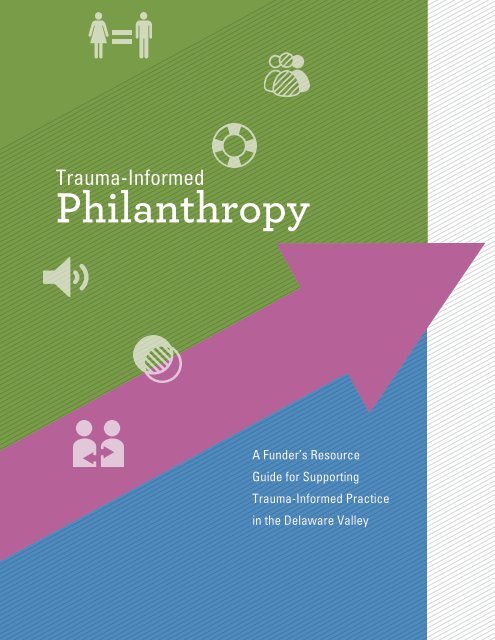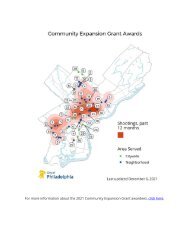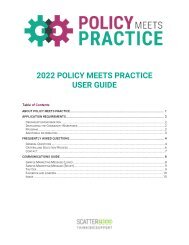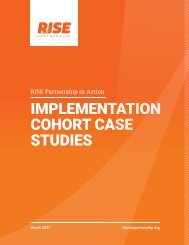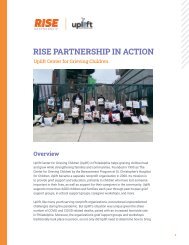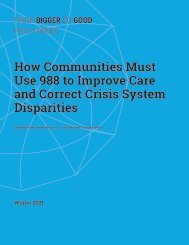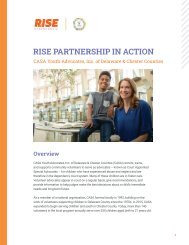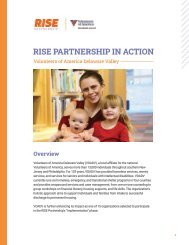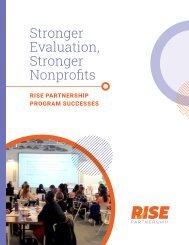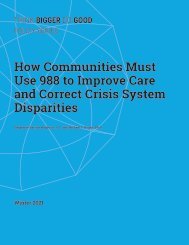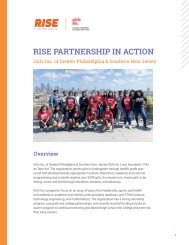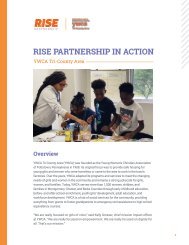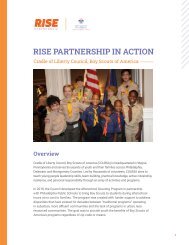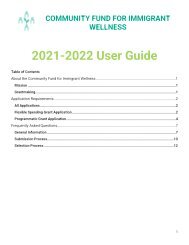Trauma-Informed Philanthropy Vol1
Create successful ePaper yourself
Turn your PDF publications into a flip-book with our unique Google optimized e-Paper software.
<strong>Trauma</strong>-<strong>Informed</strong><br />
<strong>Philanthropy</strong><br />
A Funder’s Resource<br />
Guide for Supporting<br />
<strong>Trauma</strong>-<strong>Informed</strong> Practice<br />
in the Delaware Valley
ABOUT THE AUTHORS<br />
This guide was developed as a<br />
partnership of <strong>Philanthropy</strong> Network<br />
Greater Philadelphia, Thomas<br />
Scattergood Behavioral Health<br />
Foundation, and United Way of Greater<br />
Philadelphia and Southern New Jersey<br />
with the goal of raising awareness<br />
about ACEs, trauma, and resilience<br />
among funders across all sectors.<br />
A very special thank you to the<br />
following individuals for their significant<br />
contributions to the development of<br />
this guide:<br />
• Ashley Feuer-Edwards,<br />
<strong>Philanthropy</strong> Network<br />
Greater Philadelphia<br />
• Caitlin O’Brien,<br />
Thomas Scattergood Behavioral<br />
Health Foundation<br />
• Suzanne O’Connor,<br />
United Way of Greater Philadelphia<br />
and Southern New Jersey<br />
“<br />
“Throughout my career, I’ve seen firsthand just how<br />
deeply trauma and poverty are interwoven. Whether<br />
it’s a person experiencing homelessness, someone<br />
struggling to find employment or a young family looking<br />
to find its footing, the struggle to overcome poverty is so<br />
often undermined because we ask the wrong questions.<br />
It’s not about what’s ‘wrong’ with an individual living in<br />
poverty; instead, we need to be asking, ‘What happened<br />
to you?’ and really listening to the answer to find the<br />
solutions and interventions that will make a difference<br />
and empower our neighbors to rise above poverty.”<br />
— Bill Golderer, President and CEO, United Way of Greater<br />
Philadelphia and Southern New Jersey
“Whether they know it or not, all<br />
funders are doing work that<br />
impacts individuals who have<br />
experienced trauma. Our goal with<br />
this guide is to make sure that<br />
funders can be more effective in<br />
how they address this issue.”<br />
— Joe Pyle, President, Thomas Scattergood<br />
Behavioral Health Foundation<br />
“Being trauma-informed is not easy –i t’s an ongoing,<br />
rigorous process that does not necessarily come naturally.<br />
Every organization is going to need help from their funding<br />
partners to understand how to incorporate this approach<br />
into their work, and it’s going to look different in every<br />
program. Even though it’s difficult, it’s worth it – using<br />
these practices and principles will help to transform our<br />
region to one that better supports our children, families,<br />
and communities.”<br />
— Sandra Bloom, MD,<br />
Co-founder, The Sanctuary Model ® ,<br />
Associate Professor, Drexel University
FUNDERS HAVE A<br />
RESPONSIBILITY TO<br />
UNDERSTAND HOW<br />
TRAUMA AND ACEs<br />
IMPACT OUR<br />
COMMUNITY, AND<br />
TO SUPPORT<br />
PROGRAMS IN<br />
ALL SECTORS TO<br />
PROMOTE HEALING<br />
AND RESILIENCE
contents<br />
A Vision for a <strong>Trauma</strong>-<strong>Informed</strong> Region...............................................................................................................4<br />
Purpose of this Guide.............................................................................................................................................................5<br />
Part One: Understanding <strong>Trauma</strong>-<strong>Informed</strong> Practice 6<br />
What is <strong>Trauma</strong>?.........................................................................................................................................................................6<br />
What are Adverse Childhood Experiences?....................................................................................................7<br />
ACEs and <strong>Trauma</strong>: Their Remarkable Prevalence......................................................................................8<br />
ACEs and <strong>Trauma</strong>: Their Significant Impact.....................................................................................................9<br />
Varying Responses to <strong>Trauma</strong>....................................................................................................................................10<br />
How Resilience Buffers Against ACEs and <strong>Trauma</strong>...............................................................................11<br />
What is <strong>Trauma</strong>-<strong>Informed</strong> Practice?.................................................................................................................... 12<br />
Part Two: <strong>Philanthropy</strong>’s Role in Building a <strong>Trauma</strong>-<strong>Informed</strong> Region 13<br />
What Can Funders Do?......................................................................................................................................................13<br />
Raise Awareness Within your Organization.................................................................................................14<br />
Become a <strong>Trauma</strong>-<strong>Informed</strong> Funder....................................................................................................................14<br />
Advocate for and Apply a Public Health Approach Across Sectors..................................... 18<br />
Part Three: <strong>Trauma</strong>-<strong>Informed</strong> Practice in the Delaware Valley 22<br />
How Has Our Region Embraced <strong>Trauma</strong>-<strong>Informed</strong> Practice?......................................................22<br />
A Guide to <strong>Trauma</strong>-<strong>Informed</strong> Community Initiatives............................................................................23<br />
Using <strong>Trauma</strong>-<strong>Informed</strong> Practice to Empower and Support:<br />
Witnesses to Hunger Advocates for Policy and Systems Change.........................................24<br />
Funders as Thought Leaders: Developing the Pottstown<br />
<strong>Trauma</strong> <strong>Informed</strong> Community Connection......................................................................................................26<br />
Taking a Holistic Approach to <strong>Trauma</strong>-<strong>Informed</strong> Care: Your Way Home<br />
Promotes Broad Systems Change.........................................................................................................................28<br />
A <strong>Trauma</strong>-<strong>Informed</strong> Transformation: How Hopeworks<br />
Became More Human.........................................................................................................................................................30<br />
Resources............................................................................................................................................................................................32<br />
References..........................................................................................................................................................................................33<br />
Acknowledgements...........................................................................................................................................Back cover
A VISION FOR A TRAUMA-INFORMED REGION<br />
Communities in the Delaware Valley will be safe, stable, healthy, and<br />
prosperous. Knowledge and awareness of trauma-informed practice<br />
will permeate the culture and residents will have access to supports<br />
and resources to achieve optimal social and emotional health, wellness,<br />
and success. Well-established networks will be established to connect<br />
cross-sector public and private, for-profit and non-profit partnerships<br />
which will benefit the entire region.<br />
The Delaware Valley funding community will work in partnership across<br />
all sectors to set a national example for investing in and advancing<br />
trauma-informed practice. In doing so, the Delaware Valley will become<br />
renowned for its success in working with the region’s most vulnerable<br />
citizens to improve health, wellbeing, and prosperity.<br />
“It’s not ‘What’s wrong with you?’<br />
but ‘What happened to you?’”<br />
— Joseph Foderaro, Co-Founder, The Sanctuary Model ®<br />
4 A Vision for a <strong>Trauma</strong>-<strong>Informed</strong> Region
PURPOSE OF THIS GUIDE<br />
Research tells us that while adverse<br />
childhood experiences and trauma are<br />
remarkably common and can have a<br />
significant impact on one’s life, they can<br />
also be treated and prevented. Through<br />
public education, resilience building,<br />
and healing, we can achieve our goal of<br />
building a stronger, safer, healthier, and<br />
more prosperous region.<br />
As part of these efforts, funders have a<br />
responsibility to understand how trauma<br />
and ACEs impact our community, and<br />
to support programs in all sectors to<br />
promote healing and resilience.<br />
The Delaware Valley is home to hundreds<br />
of philanthropies which provide vital<br />
resources to nonprofit organizations<br />
throughout the region. Each funder<br />
plays an integral role in shaping the<br />
programs that serve our region through<br />
financial support, thought leadership, and<br />
strategic partner building. Funders may<br />
have varying approaches to their work,<br />
but share a common goal – that residents<br />
have the resources to lead happier,<br />
healthier, more productive lives.<br />
Regardless of approach, the resources<br />
and thought leadership provided by<br />
funders will impact someone who has<br />
experienced trauma.<br />
The goal of this guide is to invite<br />
grantmakers to better understand the<br />
ways in which trauma is a root cause of<br />
poor health and social outcomes.<br />
By applying a trauma-informed lens to<br />
their work, funders can enhance their<br />
grantmaking to improve the lives of<br />
individuals, families, and communities<br />
in need. Specifically, this guide will help<br />
funders to:<br />
1. Understand the science behind trauma,<br />
adverse childhood experiences, and<br />
resilience;<br />
2. Apply trauma-informed principles and<br />
practices to their grantmaking; and<br />
3. Learn about existing local efforts to<br />
implement trauma-informed practice.<br />
The information and resources provided<br />
represent the current best practices in<br />
the trauma-informed practice movement.<br />
As new research and strategies rapidly<br />
arise to address trauma, funders<br />
are encouraged to seek out further<br />
information in order to enhance their<br />
grantmaking strategies.<br />
HISTORY OF THE ADVERSE<br />
CHILDHOOD EXPERIENCES STUDY<br />
In the mid-1980s Dr. Vincent Felitti ran<br />
an obesity clinic as a part of Kaiser<br />
Permanente’s innovative Department of<br />
Preventative Medicine in San Diego, CA.<br />
The program was mostly successful, with<br />
patients regularly losing over 100 pounds.<br />
However, despite experiencing significant<br />
weight loss, patients would mysteriously<br />
leave the program prior to achieving their<br />
goals. Year after year, approximately 50<br />
percent of the clinic’s patients dropped out<br />
of the program.<br />
Baffled by this phenomenon, Dr. Felitti<br />
reached out to these patients to learn about<br />
the barriers they faced in maintaining a<br />
healthy weight. What he heard from patients<br />
was astonishing – one of the most common<br />
characteristics among those who had left<br />
the program had experienced some form<br />
of abuse or trauma during their childhood.<br />
These stories led to a decades-long venture<br />
to discover how adversities in childhood<br />
impact adult health and wellbeing.<br />
In 1998, after conducting surveys and<br />
reviewing the medical histories of over<br />
17,000 individuals, Drs. Robert Anda and<br />
Vincent Felitti published the landmark<br />
Adverse Childhood Experiences Study. This<br />
study, the largest of its kind to date, showed<br />
that 10 different types of adverse childhood<br />
experiences, or ACEs, can have a significant<br />
impact on one’s health, social, and economic<br />
outcomes throughout their lifetime.<br />
This study has since inspired extensive<br />
subsequent research about trauma and its<br />
impact, resilience, and brain science in order<br />
to develop best practices for preventing and<br />
treating ACEs.<br />
Purpose of This Guide 5
1PART ONE<br />
Understanding<br />
<strong>Trauma</strong>-<strong>Informed</strong><br />
Practice<br />
WHAT IS TRAUMA?<br />
The term trauma is derived from the Greek word for wound. <strong>Trauma</strong> is an emotional<br />
and physical response that occurs when a person’s internal and external resources<br />
are inadequate to cope with an external threat. 1 This response can be activated<br />
by acute traumatic events (e.g. natural disaster or physical assault) and chronic<br />
traumatic situations (e.g. housing insecurity or ongoing domestic violence). 2 One<br />
may experience trauma at any point in their lives. However, research shows that<br />
when disruptive events are experienced in childhood, they can cause significant<br />
impairments to social, emotional, and cognitive development. 3<br />
6 Understanding <strong>Trauma</strong>-<strong>Informed</strong> Practice
ISOLATION<br />
Resources<br />
absent or wasted<br />
=<br />
Reduced<br />
Community<br />
Resilience<br />
Wellness<br />
Access<br />
Education<br />
WHAT ARE ADVERSE CHILDHOOD EXPERIENCES?<br />
Engagement<br />
CONNECTION<br />
Adverse Childhood Experiences (ACEs) Since the original ACE study, the<br />
Resources<br />
Self-Sufficiency<br />
are examples of traumatic or disruptive<br />
available and definition has grown to include a number<br />
Partnership<br />
events that occur before an individual used widely of other adversities. Such adversities<br />
reaches adulthood. Researchers = include Quality the Philadelphia Expanded ACEs:<br />
Increased<br />
originally identified 10 ACEs, which Community racism, Efficiency bullying, community violence,<br />
are now referred to as “Conventional Resilience neighborhood safety, and living in foster<br />
ACEs”: physical abuse and neglect, care. 5 Some studies include experiences<br />
emotional abuse and neglect, sexual such as economic hardship and parental<br />
abuse, parental incarceration, parental death as well. 6 As researchers gain a<br />
separation or divorce, parental mental deeper understanding of how these<br />
health or substance use disorder, and events impact children, the definition of<br />
witnessing domestic violence. 4<br />
ACEs continues to evolve.<br />
Figure 1<br />
TYPES OF ACEs<br />
BULLYING<br />
EXPANDED ACEs<br />
LIVING IN<br />
FOSTER<br />
CARE<br />
ABUSE<br />
Physical<br />
ABUSE<br />
Emotional<br />
Sexual<br />
Physical<br />
NEGLECT<br />
Emotional<br />
COMMUNITY<br />
VIOLENCE<br />
CONVENTIONAL<br />
ACEs<br />
Illness<br />
Mental<br />
Divorce<br />
Incarcerated<br />
Relative<br />
Caregiver<br />
Treated<br />
Violently<br />
Substance<br />
HOUSEHOLD DYSFUNCTION<br />
Abuse<br />
RACISM<br />
NEIGHBORHOOD<br />
SAFETY<br />
SOURCE:<br />
The Adverse Childhood Experiences Study<br />
and the Philadelphia Expanded ACE Study<br />
Understanding <strong>Trauma</strong>-<strong>Informed</strong> Practice 7
ACEs AND TRAUMA:<br />
THEIR REMARKABLE PREVALANCE<br />
ACEs and trauma touch every socioeconomic class, race, ethnicity, gender, sexuality, and age<br />
group. What the data tells us is that virtually everyone has either been directly impacted or<br />
knows someone who has been directly impacted by significant adverse experiences.<br />
THE ORIGINAL STUDY...<br />
Researchers analyzed data<br />
from over 17,000 individuals in<br />
San Diego, CA. The sample was<br />
largely white, middle-class,<br />
and college educated.<br />
IN PHILADELPHIA...<br />
Researchers examined<br />
14 ACEs (nine of the 10<br />
Conventional ACEs and the<br />
five Expanded ACEs) among a<br />
racially and socioeconomically<br />
diverse sample of more than<br />
1,700 Philadelphians.<br />
63.9% had experienced at least one ACE<br />
12.5% had four or more ACEs 7<br />
21.5% <br />
experienced four or more Conventional ACEs<br />
37.3% <br />
experienced four or more ACEs when all 14 indicators<br />
were included 8<br />
“It’s not just ‘them’. It’s us.”<br />
— Robert Anda, MD<br />
NATIONALLY...<br />
In 2010, 10 states and the<br />
District of Columbia surveyed<br />
their residents and found that<br />
59.3%<br />
had at least one ACE<br />
14.3%<br />
experienced four or more ACEs 9<br />
Parents of children aged 0-17<br />
identified economic hardship<br />
as their child’s most common<br />
adversity.<br />
26%<br />
of all children<br />
experiencing<br />
economic hardship<br />
“somewhat often”<br />
or “very often” 10<br />
WHAT IS THE COST?<br />
The estimated average lifetime cost per victim of nonfatal child maltreatment includes: 11<br />
$6,747<br />
in criminal justice<br />
costs<br />
$7,728<br />
in child welfare<br />
costs<br />
$7,999<br />
in special<br />
education costs<br />
$10,530<br />
in adult medical<br />
costs<br />
$32,648<br />
in childhood health<br />
care costs<br />
$144,360<br />
in productivity<br />
losses<br />
8 Understanding <strong>Trauma</strong>-<strong>Informed</strong> Practice
ACEs AND TRAUMA:<br />
THEIR SIGNIFICANT IMPACT<br />
THE FACTS:<br />
Individuals who report having<br />
four or more of the original ACEs<br />
demonstrate a higher rate of<br />
health-related disorders or<br />
behaviors. 12<br />
4.6 x<br />
depression<br />
7.4 x<br />
alcoholism<br />
10.3 x<br />
injection<br />
drug use<br />
2.2 x<br />
ischemic<br />
heart disease<br />
2.4 x<br />
stroke<br />
2.5 x<br />
sexually<br />
transmitted<br />
disease<br />
According to ChildTrends, the more ACEs a<br />
child has, the more likely they are to have:<br />
Figure 2<br />
THE ACE PYRAMID: LIFE COURSE IMPLICATIONS<br />
• low engagement in school;<br />
• their household contacted for problems at<br />
school; and<br />
• difficulty completing tasks.<br />
Among children with three or more ACEs:<br />
• one in five had to repeat a grade<br />
• almost one in four were diagnosed<br />
with a learning disability 13<br />
DEATH<br />
Early<br />
Death<br />
Disease,<br />
Disability, Social<br />
Problems<br />
Adoption of<br />
Health-risk Behaviors<br />
12.2 x<br />
Individuals who report having four or more of the<br />
original ACEs are 12.2 times as likely to have ever<br />
attempted suicide. 14<br />
Individuals who experienced six or more ACEs died<br />
nearly 20 years earlier than those with no ACEs. 15<br />
Individuals who experienced trauma<br />
are more likely to:<br />
• smoke cigarettes<br />
• engage in risky sexual behaviors<br />
Social, Emotional, and<br />
Cognitive Impairment<br />
• use illicit drugs 16<br />
Disrupted Brain Development<br />
Adverse Childhood Experiences<br />
CONCEPTION<br />
SOURCE:<br />
The Adverse Childhood Experiences Study<br />
ACEs and trauma can lead to disrupted brain development caused by toxic<br />
stress. Toxic stress can cause an overproduction of stress hormones like<br />
cortisol and adrenaline in a child’s brain and body. Too much of these stress<br />
hormones can cause significant damage to the brain, thereby impairing<br />
social, emotional, and cognitive development in children. 17<br />
Increasing<br />
population<br />
impact<br />
Counseling<br />
& Education<br />
Increasing<br />
individual<br />
effort<br />
needed<br />
Understanding <strong>Trauma</strong>-<strong>Informed</strong> Practice 9
Unaddressed traumatic<br />
experiences may<br />
trigger an episode<br />
of Post-<strong>Trauma</strong>tic<br />
Stress Disorder<br />
COMMON SIGNS AND<br />
SYMPTOMS OF PTSD:<br />
Re-experiencing<br />
symptoms such<br />
as flashbacks or<br />
nightmares<br />
Avoidance symptoms<br />
such as avoiding<br />
particular places that<br />
remind the person of the<br />
traumatic event<br />
Arousal and reactivity<br />
symptoms such as angry<br />
outbursts or difficulty sleeping<br />
Cognition and mood<br />
symptoms such as issues with<br />
self-esteem or memory loss<br />
related to the event 18<br />
VARYING RESPONSES TO TRAUMA<br />
Not everyone will have the same<br />
response to adverse events. Depending<br />
on their history of trauma, level of social<br />
support, degrees of resilience, and<br />
temperament, the consequences of a<br />
traumatic experience can range in the<br />
extent of its impact. 19<br />
For many, trauma can resolve on its<br />
own. For others, the traumatic response<br />
may lie dormant until the individual is<br />
triggered. 20 Still others may experience<br />
Post <strong>Trauma</strong>tic Stress, or PTS, which<br />
is characterized by a high degree of<br />
stress for several days or weeks after a<br />
significant event. 21 Unaddressed, PTS can<br />
lead to Post-<strong>Trauma</strong>tic Stress Disorder,<br />
or PTSD, in which symptoms are present<br />
for at least three months following the<br />
event. 22<br />
Without proper treatment, PTSD<br />
can lead to problem behaviors such<br />
as interpersonal violence and selfmedicating<br />
with drugs or alcohol. 23<br />
The National Institute of Mental Health<br />
estimates that 6.8 percent of adults will<br />
experience PTSD in their lifetime and a<br />
significant portion of that population will<br />
not receive adequate treatment. 24<br />
While this research can be startling,<br />
there is substantial evidence to show<br />
that trauma can be both treated and<br />
prevented. For youth in particular,<br />
research has shown that even just one<br />
compassionate, committed adult can<br />
significantly improve the likelihood that<br />
a child will grow to have a successful,<br />
productive adulthood. 25 By promoting<br />
approaches that include resilience<br />
building and trauma-informed practice,<br />
we can foster healing for individuals,<br />
families, and communities.<br />
10 Understanding <strong>Trauma</strong>-<strong>Informed</strong> Practice
ELEMENTS<br />
HOW RESILIENCE BUFFERS AGAINST ACES AND TRAUMA<br />
Resilience, which is a person’s capacity<br />
to overcome adversity and move forward<br />
with courage and optimism, is influenced<br />
by a confluence of factors. 26 Experts have<br />
identified human connection and access<br />
to resources as two significant elements<br />
in building individual resilience. 27<br />
These elements can be viewed as<br />
protective factors – resources, both<br />
internal and external, which reduce the<br />
impact of trauma, adversity, and toxic<br />
stress. 28 Examples include a social<br />
connectedness, 29 access to health<br />
care, quality education, and living in a<br />
safe neighborhood. 30 These factors are<br />
integral in helping one cope with trauma<br />
and can be used to explain the disparate<br />
reactions to traumatic experiences. 31 For<br />
instance, two individuals with histories<br />
of physical abuse may have varying<br />
social, behavioral, economic, and health<br />
outcomes depending on the number of<br />
protective factors they possess.<br />
ISOLATION<br />
Resources<br />
absent or wasted<br />
=<br />
Reduced<br />
Community<br />
Resilience<br />
SOURCE:<br />
Philadelphia Department of Behavioral Health<br />
and Intellectual disAbility Services and RAND Corporation<br />
Though building resilience among<br />
children and youth is a key element of the<br />
trauma-informed approach, resilience can<br />
be best supported if fostered on multiple<br />
levels. The RAND Corporation has<br />
identified eight “levers” for developing<br />
community resilience: wellness, access,<br />
education, engagement, self-sufficiency,<br />
partnership, quality, and efficiency. 32<br />
Each of these levers enable communities<br />
and their residents to bounce back in the<br />
face of traumatic events and situations.<br />
Many communities across the country<br />
are taking multi-level, multi-sector,<br />
multi-generational approaches to<br />
building resilience for their residents.<br />
These efforts have focused on<br />
increasing access to quality resources<br />
and improving connection and civic<br />
engagement. Rather than focusing<br />
on how ACEs and trauma can disrupt<br />
a person’s life, these communities<br />
are choosing to develop a strengthsbased<br />
approach, which focuses on<br />
how communities can come together<br />
to become safer, healthier, and more<br />
resilient. 33<br />
Figure 3<br />
COMMUNITY RESILIENCE FACTORS<br />
CONNECTION<br />
Resources<br />
available and<br />
used widely<br />
=<br />
Increased<br />
Community<br />
Resilience<br />
Wellness<br />
Access<br />
Education<br />
Engagement<br />
Self-Sufficiency<br />
Partnership<br />
Quality<br />
Efficiency<br />
7Dr. Kenneth Ginsburg has identified<br />
seven elements that contribute to<br />
individual resilience for children and<br />
youth. These factors are integral in a<br />
child’s development toward productive,<br />
successful adulthood:<br />
COMPETENCE<br />
When we notice what young people<br />
are doing right and give them<br />
opportunities to develop important<br />
skills, they feel competent. We<br />
undermine competence when we<br />
don’t allow young people to recover<br />
themselves after a fall.<br />
CONFIDENCE<br />
Young people need confidence to<br />
be able to navigate the world, think<br />
outside the box, and recover from<br />
challenges.<br />
CONNECTION<br />
Connections with other people,<br />
schools, and communities offer young<br />
people the security that allows them<br />
to stand on their own and develop<br />
creative solutions.<br />
CHARACTER<br />
Young people need a clear sense of<br />
right and wrong and a commitment to<br />
integrity.<br />
CONTRIBUTION<br />
Young people who contribute to the<br />
well-being of others will receive<br />
gratitude rather than condemnation.<br />
They will learn that contributing feels<br />
good and may therefore more easily<br />
turn to others, and do so without<br />
shame.<br />
COPING<br />
Young people who possess a variety<br />
of healthy coping strategies will be<br />
less likely to turn to dangerous quick<br />
fixes when stressed.<br />
CONTROL<br />
Young people who understand<br />
privileges and respect are earned<br />
through demonstrated responsibility<br />
will learn to make wise choices and<br />
feel a sense of control. 34
SAMHSA’S SIX PRINCIPLES OF TRAUMA-INFORMED ORGANIZATIONS. 36<br />
WHAT IS TRAUMA-INFORMED<br />
PRACTICE?<br />
<strong>Trauma</strong>-informed practice involves<br />
a number of key elements that focus<br />
on connection, communication, and<br />
healing. At its core, trauma-informed<br />
practice asks, “what happened to you?”<br />
rather than “what is wrong with you?”.<br />
It connects a person’s behavior to their<br />
trauma response rather than isolating<br />
their actions to the current circumstances<br />
and assuming a personality flaw.<br />
According to the Substance Abuse and<br />
Mental Health Administration (SAMHSA),<br />
“a program, organization, or system that<br />
is trauma-informed:<br />
• Realizes the widespread impact of<br />
trauma and understands potential<br />
paths for recovery;<br />
• Recognizes the signs and symptoms of<br />
trauma in clients, families, staff, and<br />
others involved with the system;<br />
• Responds by fully integrating<br />
knowledge about trauma into policies,<br />
procedures, and practices; and<br />
• Seeks to actively resist<br />
re-traumatization.” 35<br />
By utilizing trauma-informed principles<br />
in the delivery of all services and focusing<br />
on healing and resilience, programming<br />
can better address the needs of<br />
constituents who have experienced<br />
trauma.<br />
Safety<br />
Throughout the organization,<br />
staff and the people they<br />
serve feel physically and<br />
psychologically safe.<br />
Trustworthiness and<br />
transparency<br />
Organizational operations and<br />
decisions are conducted with<br />
transparency and the goal<br />
of building and maintaining<br />
trust among staff, clients,<br />
and family members of those<br />
receiving services.<br />
Peer support and mutual<br />
self-help<br />
These are integral to the<br />
organizational and service<br />
delivery approach and are<br />
understood as a key vehicle<br />
for building trust, establishing<br />
safety, and empowerment.<br />
Collaboration and mutuality<br />
There is true partnering and<br />
leveling of power differences<br />
between staff and clients<br />
and among organizational<br />
staff from direct care staff<br />
to administrators. There<br />
is recognition that healing<br />
happens in relationships and<br />
in the meaningful sharing of<br />
power and decision-making.<br />
The organization recognizes<br />
that everyone has a role to<br />
play in a trauma-informed<br />
approach. One does not<br />
have to be a therapist to<br />
be therapeutic.<br />
Empowerment, voice and<br />
choice<br />
Throughout the organization<br />
and among the clients<br />
served, individuals’<br />
strengths are recognized,<br />
built on, and validated and<br />
new skills developed as<br />
necessary. The organization<br />
aims to strengthen the<br />
staff’s, clients’, and family<br />
members’ experience of<br />
choice and recognizes that<br />
every person’s experience<br />
is unique and requires an<br />
individualized approach.<br />
This includes a belief in<br />
resilience and in the ability<br />
of individuals, organizations,<br />
and communities to heal<br />
and promote recovery<br />
from trauma. This builds<br />
on what clients, staff, and<br />
communities have to offer,<br />
rather than responding to<br />
perceived deficits.<br />
Cultural, historical<br />
and gender issues<br />
The organization actively<br />
moves past cultural<br />
stereotypes and biases (e.g.,<br />
based on race, ethnicity,<br />
sexual orientation, age,<br />
geography), offers gender<br />
responsive services,<br />
leverages the healing<br />
value of traditional cultural<br />
connections, and<br />
recognizes and addresses<br />
historical trauma.<br />
12 Understanding <strong>Trauma</strong>-<strong>Informed</strong> Practice
2PART TWO<br />
<strong>Philanthropy</strong>’s<br />
Role in Building<br />
a <strong>Trauma</strong>-<strong>Informed</strong><br />
Region<br />
WHAT CAN FUNDERS DO?<br />
With your help, we can use the science of ACEs, trauma, and resilience to better<br />
understand and address the root causes of poor social, economic, behavioral, and<br />
health outcomes. Over the course of the last decade, the Delaware Valley has been<br />
home to national leaders in the field of trauma-informed practice. Funders have<br />
an opportunity to build on their achievements and harness the momentum toward<br />
creating a trauma-informed region.<br />
This section contains information about how to use Part One of this guide to inform<br />
your work as a funder. While there is no one-size-fits-all model for becoming traumainformed,<br />
utilizing the following strategies will help funders to:<br />
1<br />
<br />
2<br />
Become<br />
3<br />
Advocate<br />
Raise awareness about the impact of ACEs and<br />
trauma with the staff and board of your organization;<br />
a trauma-informed funder by integrating<br />
trauma-informed principles into your daily work and<br />
applying trauma-informed principles to your grantmaking;<br />
and<br />
for new programs and policies that support<br />
the prevention and treatment of trauma by using a public<br />
health approach.<br />
<strong>Philanthropy</strong>’s Role in Building a <strong>Trauma</strong>-<strong>Informed</strong> Region 13
ACEs CONNECTION<br />
GROUPS THAT MAY<br />
BE OF INTEREST:<br />
Philadelphia<br />
ACEs Connection<br />
ACEs in Foster Care<br />
ACEs in the<br />
Faith Based Community<br />
ACEs in the Criminal<br />
Justice System<br />
ACEs in Child Care<br />
ACEs in Juvenile Justice<br />
ACEs in Maternal<br />
Mental Heath<br />
Taking an ACEs History–<br />
Who’s Doing it and How<br />
ACEs in Youth Services<br />
Pottstown, PA<br />
ACEs Connection<br />
1. 2. <br />
RAISE AWARENESS WITHIN YOUR<br />
ORGANIZATION<br />
One of the first steps toward becoming a<br />
trauma-informed funder is to learn more<br />
about the trauma-informed approach.<br />
Below are several ways funders can<br />
increase their knowledge and expertise<br />
of the field.<br />
1. Attend a training with your staff to learn<br />
more. The Philadelphia ACE Task Force<br />
has developed an online database of the<br />
trainings that are available in the region.<br />
They range from hour-long introductory<br />
courses to graduate-level training. It is<br />
important to have a general background<br />
in the science behind ACEs, trauma,<br />
and resilience and to stay up-to-date<br />
about current strategies which exist to<br />
address the problem.<br />
2. To remain current in your knowledge,<br />
join ACEs Connection, an online<br />
community-of-practice which aims<br />
to accelerate the global movement<br />
toward recognizing the impact of ACEs<br />
and discovering strategies which<br />
promote healing. Set aside time to<br />
read their Daily Digest, which includes<br />
current information about exciting<br />
developments in trauma-informed<br />
practice throughout the country. There<br />
are also several geographic-and sectorbased<br />
affinity groups. Consider starting<br />
your own ACEs Connection affinity<br />
group to share information about a<br />
specific sector or geographic location.<br />
3. Share this guide with your Board<br />
Members to promote knowledge and<br />
understanding among leadership.<br />
Ensuring their buy-in is an integral step<br />
toward becoming trauma-informed both<br />
in your relationships with grantees and<br />
through your grantmaking.<br />
BECOME A TRAUMA-INFORMED<br />
FUNDER<br />
In order to become a trauma-informed<br />
funder, your organization should strive<br />
to both integrate trauma-informed<br />
principles into daily work and apply these<br />
principles to grantmaking practice.<br />
Integrate <strong>Trauma</strong>-<strong>Informed</strong> Principles<br />
Into Your Daily Work<br />
Developing strong partner relationships<br />
with grantees can be a vital step<br />
toward becoming a trauma-informed<br />
funder. By working together with your<br />
grantees through open, honest, and<br />
clear communication, your organization<br />
can begin to shift toward a culture of<br />
deeper awareness and understanding of<br />
organizational and community needs.<br />
The following tips can help funders to<br />
be true stewards for trauma-informed<br />
practice throughout the region:<br />
• Be clear and open in your grantmaking<br />
process. Help applicants to best<br />
understand your organization’s<br />
standards for grantmaking.<br />
• Allow grantees to provide feedback<br />
about your grantmaking process. The<br />
Center for Effective <strong>Philanthropy</strong> has<br />
developed a Grantee Perception Report<br />
which can help you to gather and<br />
assess grantee feedback.<br />
• Ask grantees about how they would<br />
like to structure their relationship<br />
with your organization. For those who<br />
would like it, establish strong partner<br />
relationships and encourage them to<br />
utilize your knowledge, expertise, and<br />
connections to their advantage. Be sure<br />
that all grantees understand they can<br />
use your organization as a resource if<br />
they are in need of guidance.<br />
14 <strong>Philanthropy</strong>’s Role in Building a <strong>Trauma</strong>-<strong>Informed</strong> Region
• Act as a convener for your grantees,<br />
bringing them together with other<br />
programs to encourage learning and<br />
collaboration. Building a traumainformed<br />
region will require working<br />
across sectors to break down existing<br />
silos. Funders are well-positioned to<br />
convene non-traditional partners to<br />
develop new and innovative strategies<br />
to serve communities.<br />
• Learn more about diversity, equity,<br />
and inclusion to better address issues<br />
concerning race, ethnicity, gender, and<br />
sexuality.<br />
• Promote the tools and commitments of<br />
the Sanctuary Model ® both within your<br />
organization and in your communityfacing<br />
programming.<br />
APPLY TRAUMA-INFORMED PRINCIPLES TO YOUR GRANTMAKING<br />
Beyond integrating trauma-informed practice in their own work, funders should<br />
encourage current and future grantees to build trauma-informed principles into their<br />
programs. Given the prevalence of ACEs and trauma, it is imperative that programs<br />
across all sectors apply a trauma-informed lens.<br />
Strategies included on this page can help funders apply a trauma-informed principles<br />
to their grantmaking, thereby impacting the policies and practices of the programs<br />
that serve our region.<br />
Safety<br />
• Encourage the use of safety planning<br />
in programs that work directly with<br />
vulnerable populations. Safety plans<br />
can be developed in conjunction with<br />
consumers by listing safe activities<br />
that help to calm stress and anxiety.<br />
• Ensure that grantees have physically<br />
safe spaces for them to provide<br />
programming. Work with grantees<br />
to raise funds to upgrade facilities if<br />
needed.<br />
• Encourage grantees to use<br />
restorative approaches rather than<br />
punitive disciplinary strategies.<br />
Trustworthiness and transparency<br />
• Encourage grantees to engage with<br />
their constituents in their planning<br />
processes. Help them find the most<br />
effective ways to gather feedback<br />
from the individuals they work with.<br />
• When your grantees collect data<br />
from their constituents regarding the<br />
efficacy of the program, encourage<br />
them to always share their results<br />
and conclusions in an open and<br />
accessible manner.<br />
Peer support and mutual self-help<br />
• Work with grantees to find areas<br />
in their programming that can<br />
be enhanced by storytelling by<br />
individuals with lived experience.<br />
Keep in mind that some individuals<br />
may not want to share their stories.<br />
Be sure to promote safety throughout<br />
this process.<br />
• Encourage grantees to have<br />
conversations about and develop<br />
solutions to vicarious trauma<br />
and compassion fatigue among<br />
organizational staff. Promote the use<br />
of reflective supervision.<br />
Collaboration and mutuality<br />
• Help grantees to engage with their<br />
community to better understand the<br />
needs that must be addressed. Fund<br />
programs that involve community<br />
engagement strategies.<br />
• Work with grantees to develop a<br />
plan to train staff at all levels of their<br />
organization in trauma-informed<br />
practice. It is possible that not all<br />
individuals need intensive training<br />
but help grantees make informed<br />
decisions about how each staff<br />
member should be trained.<br />
Empowerment, voice and choice<br />
• Encourage grantees to utilize a<br />
person-centered, strengths-based<br />
approach in their work.<br />
• Provide funding for grantees to be<br />
trained in trauma-informed care.<br />
There are dozens of organizations<br />
that provide training to a myriad<br />
of organizations. Allow grantees<br />
to decide for themselves which<br />
trainings may be best suited to meet<br />
their needs.<br />
• Help grantees find safe ways to<br />
share information about ACEs and<br />
trauma with the individuals they<br />
serve.<br />
Cultural, historical and gender issues<br />
• Ask your grantees about the<br />
constituencies they plan to serve.<br />
Help guide them through the process<br />
of thinking about how to provide<br />
services which are culturally<br />
sensitive and connect them to<br />
appropriate resources when<br />
necessary.<br />
<strong>Philanthropy</strong>’s Role in Building a <strong>Trauma</strong>-<strong>Informed</strong> Region 15
Continuum of Change<br />
Funders must also be aware that<br />
operationalizing and implementing these<br />
principles takes a tremendous amount of<br />
effort by grantees. One key role you can<br />
have as a funder can be to help grantees<br />
understand where they lie on the<br />
Continuum of Change and how they can<br />
move toward becoming trauma-informed.<br />
Be mindful that incorporating these<br />
principles takes time – the process will<br />
be continuous and will require ongoing<br />
thought and consideration.<br />
As grantees move along the Continuum,<br />
encourage them to evaluate their work<br />
and use data to make decisions regarding<br />
next steps. Help them to understand how<br />
both process and outcome evaluation can<br />
be used to improve their programming<br />
and consider using psychometrically<br />
validated tools like the TICOMETER and<br />
the Attitudes Related to <strong>Trauma</strong>-<strong>Informed</strong><br />
Care (ARTIC) Scale in their evaluations.<br />
Further, by building evaluation into<br />
programming and reporting findings to<br />
the public, grantees will be helping to<br />
advance the field by acting as examples to<br />
other organizations and initiatives.<br />
Organizations that focus on serving individuals,<br />
families, and communities can be more effective<br />
in their work by incorporating principles which are<br />
aligned with a trauma-informed approach.<br />
The Continuum of Change can be defined<br />
by four stages:<br />
1. <strong>Trauma</strong>-Aware: Organizations have<br />
become aware of how prevalent trauma<br />
is and have begun to consider that it<br />
might impact their clientele and staff.<br />
2. <strong>Trauma</strong>-Sensitive: Organizations<br />
have begun to 1) explore SAMHSA’s<br />
Six Principles of <strong>Trauma</strong>-<strong>Informed</strong><br />
Organizations within their environment<br />
and daily work; 2) build consensus<br />
around the principles; 3) consider the<br />
implications of adopting the principles<br />
within the organization; and 4) prepare<br />
for change.<br />
3. <strong>Trauma</strong>-Responsive: Organizations<br />
have begun to change their<br />
organizational culture to highlight<br />
the role of trauma and resilience. At<br />
all levels of the organization, staff<br />
begins re-thinking the routines and<br />
infrastructure of the organization.<br />
4. <strong>Trauma</strong>-<strong>Informed</strong>: Organizations have<br />
made trauma-responsive practices<br />
the organizational norm. The trauma<br />
model has become so accepted and<br />
so thoroughly embedded that it no<br />
longer depends on a few leaders. The<br />
organization works with other partners<br />
to strengthen trauma-informed practice<br />
in their communities.<br />
16 <strong>Philanthropy</strong>’s Role in Building a <strong>Trauma</strong>-<strong>Informed</strong> Region
Figure 4<br />
THE CONTINUUM OF CHANGE<br />
<strong>Trauma</strong>-informed practice is not simply a program model that can be implemented and monitored by a fidelity<br />
checklist. Rather, it is a profound paradigm shift in knowledge, perspective, attitudes, and skills that continues to<br />
unfold and deepen over time. The Continuum of Change includes questions that may be used to better understand<br />
partner strengths and needs. Funders can also use the Continuum to assess their own integration of trauma-informed<br />
principles into daily work and grantmaking practice.<br />
<strong>Trauma</strong>-Aware<br />
• Do most staff understand<br />
the term ‘trauma’? Are<br />
they aware that this<br />
knowledge can change<br />
they way they view and<br />
interact with others?<br />
• Is information about<br />
ACEs and trauma<br />
referenced in informal<br />
conversations?<br />
• Is workplace safety a<br />
priority and does your<br />
organization consider<br />
both physical and mental<br />
health?<br />
t<br />
<strong>Trauma</strong>-Sensitive<br />
SOURCE<br />
This framework was adapted by the Philadelphia<br />
ACE Task Force from the Missouri Model:<br />
A Development Framework for <strong>Trauma</strong>-<strong>Informed</strong><br />
• Does your organization<br />
value a trauma-informed<br />
lens and identify trauma<br />
and resilience in your<br />
policies?<br />
• Is trauma training<br />
institutionalized for all<br />
staff?<br />
• Is basic information about<br />
ACEs and trauma made<br />
visually available to staff?<br />
• Does your staff<br />
feel supported and<br />
understood in the<br />
workplace?<br />
• Does your organization<br />
promote a culture of<br />
democratic decisionmaking?<br />
• Does management<br />
recognize compassion<br />
fatigue and vicarious<br />
trauma?<br />
t<br />
<strong>Trauma</strong>-Responsive<br />
• Does staff apply<br />
knowledge of trauma<br />
and resilience to specific<br />
work?<br />
• Does your staff<br />
utilize language that<br />
supports safety,<br />
choice, collaboration,<br />
trustworthiness, and<br />
empowerment?<br />
• Do policies support<br />
addressing vicarious<br />
trauma among staff?<br />
• Does your organization<br />
promote a culture of<br />
democratic decision<br />
making and shared<br />
responsibility in problem<br />
solving and conflict<br />
resolution?<br />
• Does your organization<br />
utilize a “universal<br />
precautions” approach<br />
in which everyone is<br />
screened for ACEs and/or<br />
trauma?<br />
• Are people with lived<br />
experience encouraged<br />
to take meaningful roles<br />
in institutional change?<br />
• Have changes been<br />
made to the physical<br />
environment to reflect<br />
trauma-informed<br />
policies?<br />
• Are trauma-specific<br />
assessment and<br />
treatment models<br />
available for those who<br />
need them?<br />
t<br />
<strong>Trauma</strong>-<strong>Informed</strong><br />
• Is your entire staff skilled<br />
in using trauma-informed<br />
practices?<br />
• Does everyone involved<br />
in the organization feel<br />
that they are a part of<br />
the decision-making<br />
process?<br />
• Do individuals outside<br />
of your organization<br />
understand that trauma<br />
and resilience are at the<br />
center of your mission?<br />
• Is your organization<br />
viewed as a leader<br />
in trauma-informed<br />
practice?<br />
• Does your organization<br />
use data to drive<br />
decisions at every level?<br />
• Are a variety of<br />
sustainable trainings<br />
including ongoing<br />
coaching and<br />
consultation made<br />
available to staff?<br />
• Does your organization’s<br />
business model and<br />
fiscal structure consider<br />
the need to address<br />
trauma?<br />
<strong>Philanthropy</strong>’s Role in Building a <strong>Trauma</strong>-<strong>Informed</strong> Region 17
3. ADVOCATE FOR AND APPLY A PUBLIC HEALTH<br />
APPROACH ACROSS SECTORS<br />
“Children’s exposure to Adverse Childhood<br />
Experiences is the greatest unaddressed<br />
public health threat facing our nation today.”<br />
ACEs and trauma and have been called<br />
one of the worst public health crises of<br />
our time, thereby necessitating a public<br />
health perspective when advocating<br />
for broader systems change. As a field,<br />
public health aims to take an upstream<br />
approach to promoting health and<br />
wellness and decreasing the incidence<br />
and prevalence of disease.<br />
Utilizing a public health framework will<br />
allow us to have wider-ranging impact<br />
than the traditional disease-centric<br />
model, which aims to address health only<br />
as the absence of illness. This approach<br />
also require a wider range of partners<br />
who focus on issues such as poverty,<br />
education, community infrastructure, and<br />
even transportation – all of which have a<br />
significant impact on population health.<br />
Using a public health approach to help<br />
bring about broader systems change will<br />
help funders to bring multiple sectors to<br />
the table. Ultimately, breaking down silos<br />
to encourage cross-sector, multi-level<br />
program and policy change will be the<br />
most effective way to prevent adverse<br />
childhood experiences and promote<br />
healing.<br />
Grantmakers have the ability to leverage<br />
funds to advocate for innovative, traumainformed<br />
public policies and practices.<br />
Promoting the innovative work of their<br />
grantees and providing opportunities for<br />
grantees to partner with local, state, and<br />
federal governments can help to foster<br />
broader systems change. Funders may<br />
also work with public agencies to develop<br />
pilot programs which test new models,<br />
which could then be scaled up with public<br />
funds. Private capital is key to bringing<br />
about new strategies for change and can<br />
ultimately help to transform our current<br />
systems.<br />
— Robert Block, MD, former president of<br />
the American Academy of Pediatrics<br />
18 <strong>Philanthropy</strong>’s Role in Building a <strong>Trauma</strong>-<strong>Informed</strong> Region
Physica<br />
otional<br />
CONVENTIONAL<br />
ACEs<br />
Illness<br />
Mental<br />
Divorce<br />
Incarcerated<br />
Relative<br />
Caregiver<br />
Treated<br />
Violently<br />
Substance<br />
HOUSEHOLD DYSFUNCTION<br />
Abuse<br />
When advocating for public policies that are informed by the science behind ACEs and trauma, consider this model: 37<br />
<strong>Trauma</strong>-Preventive Policies:<br />
Polices that are not necessarily designed<br />
with the explicit intent of addressing<br />
traumatic stress, but have great potential<br />
to do so by reducing exposure and<br />
promoting resilience.<br />
RACISM<br />
<strong>Trauma</strong>-<strong>Informed</strong> Policies:<br />
Policies that reflect knowledge about<br />
the prevalence of trauma exposure in a<br />
population and how the effects of trauma<br />
could have secondary consequences.<br />
<strong>Trauma</strong>-Specific NEIGHBORHOODPolicies:<br />
Policies SAFETY that promote access to<br />
interventions that mitigate the<br />
effects of trauma exposure and promote<br />
recovery.<br />
Figure 5<br />
A CROSS-SECTOR PUBLIC HEALTH<br />
APPROACH FOR ADDRESSING ACEs<br />
AND TRAUMA<br />
Tertiary Prevention: TREATMENT<br />
Secondary Prevention: AT-RISK<br />
Primary Prevention: UNIVERSAL PRECAUTIONS<br />
MENTAL HEALTH<br />
HEALTH CARE<br />
CHILD WELFARE<br />
EARLY CHILDHOOD<br />
EDUCATION<br />
WELFARE<br />
HOUSING<br />
JUSTICE<br />
CORRECTIONS<br />
SOURCE:<br />
Sandra Bloom, MD<br />
<strong>Philanthropy</strong>’s Role in Building a <strong>Trauma</strong>-<strong>Informed</strong> Region 19
Figure 6<br />
STAGES OF PREVENTION<br />
Primary<br />
Prevents the disease or<br />
injury before it occurs.<br />
PREVENTION<br />
This typically means taking a<br />
systems-level approach to making<br />
spaces healthier, incentivizing<br />
health behaviors, etc.<br />
Legislators pass laws that aim<br />
to alleviate poverty and provide<br />
adequate social supports to<br />
enhance protective factors and<br />
build resilience<br />
Parents have access to trainings<br />
to educate them about the impact<br />
of ACEs and provide them with<br />
strategies to parent with a<br />
trauma-informed lens<br />
Schools implement a Social<br />
Emotional Learning curriculum<br />
Secondary<br />
Reduces the impact of a<br />
disease, illness, or injury once<br />
it has already occurred.<br />
SCREENING<br />
This can be done through<br />
screening and early<br />
detection.<br />
Pediatricians can provide<br />
ACEs screenings and<br />
connect children<br />
to care as needed<br />
Schools conduct ACE<br />
screenings and connect<br />
students to<br />
appropriate care<br />
Tertiary<br />
Treats the ongoing health<br />
condition or injury in order to<br />
better one’s quality of life.<br />
TREATMENT<br />
This typically will<br />
include individual,<br />
clinical care by a<br />
licensed provider.<br />
A person seeks<br />
treatment for<br />
Post-<strong>Trauma</strong>tic<br />
Stress Disorder<br />
20 <strong>Philanthropy</strong>’s Role in Building a <strong>Trauma</strong>-<strong>Informed</strong> Region<br />
The Stages of Prevention<br />
The prevention of ACEs and trauma can<br />
be promoted through addressing the social<br />
determinants of health. These consist<br />
of the “conditions in which people are<br />
born, live, learn, work, play, worship, and<br />
age that affect a wide range of health,<br />
functioning, and quality-of-life outcomes<br />
and risks.” 38 Addressing social issues like<br />
poverty, violence, unemployment, and<br />
In terms of public policy, consider this model: 34 education can help to reduce the incidence<br />
of trauma.<br />
<strong>Trauma</strong>-Preventive<br />
Policies<br />
PREVENTIVE<br />
Polices that are not<br />
necessarily designed<br />
with the explicit intent of<br />
addressing traumatic<br />
stress, but have great<br />
potential to do so by<br />
reducing exposure and<br />
promoting resilience.<br />
Addressing the impact of ACEs and<br />
trauma will also require a “universal<br />
precautions” 39 approach to screening.<br />
When working with children, youth and<br />
families, <strong>Trauma</strong>-<strong>Informed</strong><br />
professionals must assume the<br />
Policies<br />
likelihood of a trauma history and treat<br />
every individual with appropriate caution<br />
and care. This Policies approach that reflect will necessitate<br />
knowledge about the<br />
all sectors to incorporate trauma-informed<br />
prevalence of trauma<br />
practice into their work – allowing for more<br />
exposure in a population<br />
compassionate<br />
and how<br />
interactions<br />
the effective<br />
throughout<br />
all systems. of trauma could have<br />
secondary consequences<br />
INFORMED<br />
Treatment is also an important element<br />
of addressing trauma and ACEs. Funders<br />
can suggest evidence-based clinical<br />
models such as <strong>Trauma</strong>-Focused Cognitive<br />
Behavioral Therapy and Eye Movement<br />
Desensitization and Reprocessing (EMDR)<br />
for programs that provide behavioral health<br />
services. Funders may also encourage<br />
the use emerging therapies such as<br />
Somatosensory interventions. Within<br />
public systems like Medicare and Medicaid,<br />
funders can help to build awareness and<br />
advocate for trauma-informed treatment<br />
models in both physical and behavioral<br />
health.<br />
Though we encourage utilizing a public<br />
health approach, it is important to<br />
note that outcomes related to health<br />
are only one piece of what we should<br />
encourage grantees to seek through their<br />
<strong>Trauma</strong>-Specific<br />
Policies programming. Change in health outcomes<br />
may take several years, if not decades,<br />
to occur. Rather, we can look to social,<br />
behavioral, Policies economic, that promote and educational<br />
access to interventions<br />
outcomes which, in turn, can have a<br />
SPECIFIC<br />
that mitigate the<br />
significant impact on population health.<br />
effects of trauma<br />
exposure and promote<br />
recovery. 29
RESOURCES FOR IMPLEMENTING A TRAUMA-INFORMED APPROACH ACROSS SECTORS<br />
The resources provided here are related to a wide variety of sectors and exemplify ways in which programs can apply<br />
a trauma-informed approach to address this public health crisis.<br />
SECTOR RESOURCE SECTOR RESOURCE<br />
Multi-Sector<br />
Responding to Childhood <strong>Trauma</strong>: The Promise and Practice of<br />
<strong>Trauma</strong> <strong>Informed</strong> Care, Pennsylvania Office of Mental Health<br />
and Substance Abuse Services<br />
Creating <strong>Trauma</strong>-<strong>Informed</strong> Systems: Child Welfare, Education,<br />
First Responders, Health Care, Juvenile Justice, Published in<br />
Professional Psychology: Research and Practice<br />
Developing <strong>Trauma</strong> <strong>Informed</strong> Organizations,<br />
Institute for Health and Recovery<br />
<strong>Trauma</strong>-<strong>Informed</strong> Care and <strong>Trauma</strong>-Specific Services:<br />
A Comprehensive Approach to <strong>Trauma</strong> Intervention,<br />
American Institutes for Research<br />
<strong>Trauma</strong>-<strong>Informed</strong> Community Building,<br />
Bridge Housing Corporation and Health Equity Institute<br />
Developmental<br />
Disabilities<br />
Domestic<br />
Violence<br />
Education<br />
Facts on <strong>Trauma</strong>tic Stress and Children with Developmental<br />
Disabilities, National Child <strong>Trauma</strong>tic Stress Network<br />
<strong>Trauma</strong>-<strong>Informed</strong> Care: Best Practices and Protocols for Ohio’s<br />
Domestic Violence Programs, Ohio Department of Mental Health<br />
Helping <strong>Trauma</strong>tized Children Learn, Massachusetts Advocates<br />
for Children<br />
Child <strong>Trauma</strong> Toolkit for Educators, National Child <strong>Trauma</strong>tic<br />
Stress Network<br />
The Heart of Learning and Teaching: Compassion, Resiliency, and<br />
Academic Success, Washington State Office of Superintendent<br />
of Public Instruction<br />
An <strong>Informed</strong> Approach to Teaching Children Who are Living in<br />
Poverty, ChildCare Exchange<br />
Arts<br />
Calm Through Creativity: How Arts Can Aid <strong>Trauma</strong> Recovery,<br />
National Clearinghouse on Families and Youth<br />
How Schools Can Help Students Recover from <strong>Trauma</strong>tic<br />
Experiences, Rand Corporation<br />
Behavioral Health<br />
A Treatment Improvement Protocol: <strong>Trauma</strong>-<strong>Informed</strong> Care in<br />
Behavioral Health Services, Substance Abuse and Mental<br />
Health Services Administration<br />
Models for Developing <strong>Trauma</strong>-<strong>Informed</strong> Behavioral Health<br />
Systems and <strong>Trauma</strong>-Specific Services, National Center for<br />
<strong>Trauma</strong>-<strong>Informed</strong> Care<br />
Implementing <strong>Trauma</strong>-<strong>Informed</strong> Approaches in Access to<br />
Recovery Programs, Access to Recovery<br />
Health Care<br />
Homelessness<br />
and Housing<br />
LGBTQ Issues<br />
Healing Together: Community-Level <strong>Trauma</strong>, Johns Hopkins<br />
Urban Health Institute<br />
A Long Journey Home: A Guide for Creating <strong>Trauma</strong>-<strong>Informed</strong><br />
Services for Mothers and Children Experiencing Homelessness,<br />
Substance Abuse and Mental Health Services Administration<br />
Practice Guidelines for the Delivery of <strong>Trauma</strong>-<strong>Informed</strong> and<br />
GLBTQ Culturally Competent Care, WestEd; American Institutes<br />
for Research; and Justice Resource Initiative<br />
Child Welfare<br />
Criminal Justice<br />
Implementing <strong>Trauma</strong>-<strong>Informed</strong> Practices in Child Welfare,<br />
State Policy Advocacy and Reform Center;<br />
First Focus; and ABA Center on Children and the Law<br />
Child Welfare <strong>Trauma</strong> Training Toolkit: Comprehensive Guide –<br />
2nd Edition, National Child <strong>Trauma</strong>tic Stress Network<br />
Essential Components of <strong>Trauma</strong>-<strong>Informed</strong> Judicial Practice,<br />
Substance Abuse and Mental Health Services Administration<br />
First, Do No Harm: Model Practices for Law Enforcement<br />
Agencies When Arresting Parents in the Presence of Children,<br />
OJP Diagnostic Center and Strategies for Youth<br />
Creating a <strong>Trauma</strong>-<strong>Informed</strong> Criminal Justice System<br />
for Women: Why and How, Substance Abuse and Mental<br />
Health Services Administration<br />
Veterans<br />
Women and Girls<br />
Youth Violence<br />
A <strong>Trauma</strong>-<strong>Informed</strong> Curriculum for Lesbian, Gay, Bisexual,<br />
Transgendered, Questioning, Intersexed, and Two-Spirit<br />
(LGBTQI2-S) Youth, Substance Abuse and Mental Health<br />
Services Administration<br />
Brief Series: <strong>Trauma</strong>-<strong>Informed</strong> Care for Veterans Experiencing<br />
Homelessness, American Institutes for Research<br />
Instilling Hope in Veterans with PTSD: Integrating <strong>Trauma</strong>-<br />
<strong>Informed</strong> Care with Recovery Principles, North Start Behavioral<br />
Health System<br />
Becoming <strong>Trauma</strong>-<strong>Informed</strong>: A Core Element in Women’s<br />
Treatment, Counselor Magazine<br />
Healing the Hurt: <strong>Trauma</strong>-<strong>Informed</strong> Approaches to the Health of<br />
Boys and Young Men of Color, Drexel University<br />
<strong>Philanthropy</strong>’s Role in Building a <strong>Trauma</strong>-<strong>Informed</strong> Region 21
PART THREE<br />
<strong>Trauma</strong>-<strong>Informed</strong> Practice<br />
in the Delaware Valley<br />
3HOW HAS OUR REGION EMBRACED TRAUMA-INFORMED PRACTICE?<br />
<strong>Trauma</strong>-informed practice can be implemented on many different levels. Throughout<br />
the Delaware Valley, organizations and communities have been working to integrate<br />
trauma-informed practice into their programs, thereby more effectively serving<br />
vulnerable populations.<br />
In this section, you will find examples of initiatives and programs that demonstrate<br />
the use of trauma-informed practice. First, you will find a map with cross-sector<br />
coalitions and networks which aim to prevent and treat ACEs and trauma on the<br />
community level and use trauma-informed practice as a basis for their work. Second,<br />
you will find four case studies which represent why trauma-informed care is important<br />
and how trauma-informed practice can be used to enhance programming and<br />
promote healing.<br />
22 <strong>Trauma</strong>-<strong>Informed</strong> Practice in the Delaware Valley
A Guide to<br />
<strong>Trauma</strong>-<strong>Informed</strong><br />
Community<br />
Initiatives<br />
The following examples represent just a small number of<br />
organizations, projects, and initiatives that have embraced<br />
trauma-informed practice. Throughout the Delaware Valley,<br />
dozens of communities, organizations, and service providers<br />
are striving toward the prevention and treatment of ACEs<br />
and trauma while also promoting healing and resilience.<br />
INITIATIVES &<br />
KEY FUNDERS<br />
Pottstown <strong>Trauma</strong> <strong>Informed</strong><br />
Community Connection<br />
Pottstown, PA<br />
• W.K. Kellogg Foundation<br />
• United Way of Greater Philadelphia<br />
and Southern New Jersey<br />
• Pottstown Area Health and<br />
Wellness Foundation<br />
Bucks<br />
Philadelphia ACE Task Force<br />
Philadelphia, PA<br />
Chester<br />
Montogomery<br />
Philadelphia<br />
• Robert Wood Johnson Foundation<br />
• First Hospital Foundation<br />
• Annie E. Casey Foundation<br />
• Stoneleigh Foundation<br />
• Thomas Scattergood Behavioral<br />
Health Foundation<br />
22nd Police District<br />
Philadelphia, PA<br />
Delaware<br />
Burlington<br />
• Stoneleigh Foundation<br />
• William Penn Foundation<br />
• Genuardi Family Foundation<br />
• Department of Justice<br />
Gloucester<br />
Camden<br />
Healing 10<br />
Camden, NJ<br />
Salem<br />
• Thomas Scattergood Behavioral<br />
Health Foundation<br />
• The Claneil Foundation<br />
Building a <strong>Trauma</strong>-<strong>Informed</strong> Region<br />
Atlantic<br />
PA Counties: Delaware,<br />
Montgomery, Philadelphia, Chester<br />
Cumberland<br />
NJ Counties: Atlantic, Burlington,<br />
Camden, Cape May, Cumberland<br />
Cape May<br />
• United Way of Greater<br />
Philadelphia and Southern<br />
New Jersey’s Impact Fund<br />
• CHG Charitable Trust<br />
Mobilizing Action for<br />
Resilient Communities<br />
Nationwide<br />
• Robert Wood Johnson Foundation<br />
• The California Endowment<br />
Understanding <strong>Trauma</strong>-<strong>Informed</strong> Practice 23 17
Using <strong>Trauma</strong>-<strong>Informed</strong> Practice<br />
to Empower and Support<br />
Witnesses to Hunger Advocates for Policy<br />
and Systems Change<br />
Myra Young is frustrated. She has two children, one nine-year-old and one<br />
five-year-old. Her husband, who was working when they got married, injured<br />
his back at work several years ago and now receives Social Security as his<br />
income. When this happened, the government adjusted her TANF benefits<br />
to just $32 per month. She works, but still struggles to make ends meet. “I’m<br />
trying to find programs help me take care of my family,” she says. “I have to<br />
be a mother before I can be a friend.”<br />
24 <strong>Trauma</strong>-<strong>Informed</strong> Practice in the Delaware Valley
“Living in poverty can be quite traumatic,” says<br />
Michelle Taylor, program manager for Witnesses<br />
to Hunger, a program of the Center for Hunger Free<br />
Communities at the Drexel University Dornsife<br />
School of Public Health. “Many of the members<br />
have experienced undeniable hardships in<br />
their lives.”<br />
Young became involved in Witnesses to Hunger<br />
back in 2008 when her older son had an asthma<br />
attack. While at the hospital, she was asked<br />
to complete a survey and to take a camera to<br />
document her experience living in poverty. Since<br />
then, Young has been committed to Witnesses<br />
to Hunger, using her camera and voice to tell<br />
her story to people in power – people who<br />
could help change her situation. Through this<br />
program, she says, she’s found family. “I call all<br />
of [the witnesses] my sisters,” she says, “If I’m<br />
depressed, I can talk to them and it feels good to<br />
have someone in my corner.” Taylor echoes the<br />
importance of these bonds, stating how powerful<br />
it can be to see this community rally together to<br />
support one another.<br />
The goal of Witnesses to Hunger is to actively<br />
engage individuals who have lived experience<br />
raising a child on a limited income to themselves<br />
become advocates for new policy solutions.<br />
Taylor says that while the program is remarkably<br />
effective in challenging notions of poverty and<br />
“[<strong>Trauma</strong>-informed care] is a crucial<br />
part of our work and what makes this<br />
kind of advocacy most effective and<br />
sustainable.”<br />
the people it impacts, it does not come without<br />
its challenges. “It is important that as we work to<br />
change how people perceive them, that we also<br />
work to support them,” she says. She stresses<br />
the importance of approaching people with the<br />
understanding that they may have had exposure<br />
to trauma and that, as staff, you must have the<br />
appropriate training to work with individuals<br />
as well as the support necessary to deal with<br />
vicarious trauma.<br />
“I call all of [the witnesses]<br />
my sisters.”<br />
Thus, Witnesses to Hunger has become committed<br />
to a holistic approach to trauma-informed care<br />
and practice, checking in at every meeting – no<br />
matter who is in attendance – to see where<br />
everyone is. “We encourage staff and members<br />
to participate in trauma-informed training and<br />
education to improve our skills in dealing with<br />
trauma. It’s a crucial part of our work and what<br />
makes this kind of advocacy most effective and<br />
sustainable,” says Taylor.<br />
She explains, though, that training can be<br />
expensive and time intensive. She states that<br />
when funders begin to understand how their<br />
money can directly improve the community, they<br />
can have huge impact over time and across a<br />
broad range of issues.<br />
<strong>Trauma</strong>-<strong>Informed</strong> Practice in the Delaware Valley 25
pottstown<br />
Funders as Thought Leaders<br />
Developing the Pottstown <strong>Trauma</strong> <strong>Informed</strong><br />
Community Connection<br />
For over a decade, Pottstown, PA has been home to the Pottstown Early<br />
Action for Kindergarten Readiness (PEAK) initiative, a partnership between<br />
Pottstown School District and community agencies. Developed to ensure<br />
quality early childhood education and connections to services, PEAK has<br />
paved the way for enhanced family engagement, higher teacher quality,<br />
and strong community partnerships. In 2014, PEAK was the recipient of a<br />
Community Innovation Zone grant from the state, leading PEAK coordinator,<br />
Mary Rieck, to think, “how else could we serve the community?”<br />
26 <strong>Trauma</strong>-<strong>Informed</strong> Practice in the Delaware Valley
The PEAK initiative was already seeking ways to<br />
better connect with caregivers and families and<br />
through a grant with the W. K. Kellogg Foundation,<br />
they were able to develop a Family Advisory<br />
Committee (FAC). The approach of the W. K.<br />
Kellogg Foundation is to identify major issues<br />
through this kind of direct community engagement,<br />
according to Jon-Paul Bianchi, who is a program<br />
officer there.<br />
Engagement with the FAC confirmed what PEAK<br />
staff had been experiencing in their classrooms –<br />
children in Pottstown were facing extensive social<br />
and behavioral issues both at school and at home.<br />
At around the same time, Rieck was introduced to<br />
the concept of ACEs, trauma, and resilience from<br />
one of PEAK’s Managing Partners at the United<br />
Way of Greater Philadelphia and Southern New<br />
Jersey. Inspired by what they were learning from<br />
the community and her partners in philanthropy,<br />
the PEAK Managing Partners decided that working<br />
toward a trauma-informed community would<br />
be the most effective way to achieve desired<br />
outcomes of local families.<br />
So, they began to do the work of pulling together<br />
a steering committee with representatives from<br />
the school district, police department, behavioral<br />
health providers, social service agencies, and<br />
philanthropic partners. With roughly 26 individuals<br />
from 11 different organizations, the Pottstown<br />
<strong>Trauma</strong> <strong>Informed</strong> Community Connection (PTICC)<br />
began to take form. The Pottstown Area Health<br />
& Wellness Foundation connected Rieck with<br />
consultants who would help them develop a theory<br />
of change and logic model, which have helped<br />
the steering committee to be strategic in their<br />
programming and think about how to best evaluate<br />
their outcomes.<br />
Through their partnership with the W. K. Kellogg<br />
Foundation, the PEAK team, along with other<br />
employees of the Pottstown School District, had<br />
the opportunity to learn about Second Step, a<br />
social emotional learning (SEL) curriculum. They<br />
visited Austin, TX, where this curriculum had<br />
been implemented as a part of a comprehensive<br />
SEL approach.<br />
“The best intervention for student<br />
achievement are to strengthen kids’<br />
emotional faculties.”<br />
Impressed by the increased attendance and<br />
decreases in school violence that came as a<br />
result of the new curricula, the Pottstown team<br />
acted quickly to implement this into their own<br />
curriculum. Starting in the 2016-2017 school<br />
year, Second Step will be implemented in<br />
60 classrooms, including all early childhood<br />
education centers and in many classrooms<br />
grades K-8. The SEL strategy will include explicit<br />
instruction, climate and culture, integration<br />
and family and community. There will be a full<br />
implementation at all grade levels Pre-K-9 in the<br />
following school year. “The best interventions<br />
for student achievement are to strengthen kids’<br />
emotional faculties,” says Bianchi, “I think it’s<br />
smart to undergird the work with a traumainformed<br />
approach.”<br />
In just a couple of years, PTICC has garnered<br />
significant attention in the Pottstown community.<br />
They hosted their first Community Partners<br />
Meeting in July of 2016, inviting individuals from<br />
local agencies, organizations, and businesses to<br />
learn more about the initiative. Their goal was to<br />
have 50 people attend – 125 came.<br />
Much of the inspiration for PTICC came from<br />
their philanthropic partners sharing information<br />
about trauma and stories about what successful<br />
strategies exist to address it. Built on strong<br />
relationships with community organizations and<br />
private funders, PTICC has been able to leverage<br />
funds to empower the community to get involved.<br />
<strong>Trauma</strong>-<strong>Informed</strong> Practice in the Delaware Valley 27
Taking a Holistic Approach<br />
to <strong>Trauma</strong>-<strong>Informed</strong> Care<br />
Your Way Home Promotes Broad Systems Change<br />
“Is your environment trauma-informed or just you?” asks Russell<br />
Johnson, president and CEO of the HealthSpark Foundation. It is critical<br />
that programs take a careful and holistic approach to implementing<br />
trauma-informed care – a point that Johnson is stressing as traumainformed<br />
practice is introduced into the programming of Your Way<br />
Home, a public-private partnership which aims to address homelessness<br />
in Montgomery County, PA.<br />
28 <strong>Trauma</strong>-<strong>Informed</strong> Practice in the Delaware Valley
Established in 2014, Your Way Home was<br />
developed in response to a Community Needs<br />
Assessment. Conducted by Temple University, the<br />
assessment found that housing and homelessness<br />
services were difficult to access for both<br />
consumers and providers. “People were doing a<br />
lot of work and provision of services but not in a<br />
cohesive manner,” says Johnson.<br />
“<strong>Trauma</strong>-informed care is<br />
essential to do the work well.”<br />
Inspired by EveryOne Home, a similar program in<br />
Alameda County, CA, Your Way Home developed<br />
both a call center and Housing Resource Centers<br />
which can be utilized by individuals experiencing<br />
housing insecurity. Staffed by both case workers<br />
who work directly with clients and with housing<br />
locators who work with landlords to identify<br />
housing solutions, the Housing Resource Centers<br />
have ensured that there is a continuum of care for<br />
individuals facing homelessness.<br />
In addition to developing a coordinated entry<br />
system, Your Way Home moved from a first come,<br />
first serve model to one based on the level of<br />
acuity. “In the shift from first come, first serve to<br />
serving the most vulnerable citizens first we had a<br />
dramatic shift in the individuals we were serving,”<br />
says Emma Hertz, program office administrator for<br />
the Montgomery County Department of Housing<br />
and Community Development, which oversees<br />
the Your Way Home initiative. She added that this<br />
shift resulted in staff serving populations which<br />
required much more significant supports.<br />
As the direct service staff gained experience with<br />
this higher-acuity population, they also began<br />
asking for training in trauma-informed care. “We<br />
can’t achieve the results we want if staff don’t<br />
have good training and emphasis on self-care,”<br />
says Hertz, “trauma-informed care is essential<br />
to do the work well.” Through the United Way of<br />
Greater Philadelphia and Southern New Jersey,<br />
Your Way Home will be offering comprehensive<br />
training to direct service staff.<br />
“The experience of homelessness is such an<br />
unusual experience of trauma,” says Johnson,<br />
“we’re already engaging them at such a<br />
compromised point.” He argues that trauma<br />
training may not be enough, “the investment you<br />
make may not pay off if you don’t think holistically<br />
about what you’re trying achieve.”<br />
In addition to the trainings for direct service<br />
providers, Your Way Home will be conducting<br />
supplemental training for supervisors and<br />
executive directors so that they are able develop<br />
and nurture trauma-informed environments for<br />
their staff and consumers. Further, they will be<br />
encouraged to revise their operations manuals to<br />
ensure that all policies and procedures reflect a<br />
trauma-informed approach.<br />
Still, some necessary procedures could potentially<br />
trigger traumatizing experiences for clients.<br />
For instance, Johnson explains that Your Way<br />
Home conducts a vulnerability assessment with<br />
everyone who visits their Housing Resource<br />
Centers. Though some questions may call attention<br />
to a client’s trauma history, it is necessary for staff<br />
to glean this information in order to assess the<br />
client’s level of acuity. The key, he says, is to offer<br />
a holistic experience that assures safety and a<br />
willingness to be supportive of the needs of each<br />
client and client family.<br />
<strong>Trauma</strong>-<strong>Informed</strong> Practice in the Delaware Valley 29
A <strong>Trauma</strong>-<strong>Informed</strong><br />
Transformation<br />
How Hopeworks Became More Human<br />
Dan Rhoton, executive director of Hopeworks ‘N Camden, may be best described<br />
as a trauma-informed practice evangelist. “<strong>Trauma</strong>-<strong>Informed</strong> care is what makes<br />
Hopeworks effective,” he says. Hopeworks ‘N Camden, more commonly known<br />
as Hopeworks, is a community-based non-profit providing trauma-informed<br />
workforce development and training to adolescents and young adults in Camden,<br />
New Jersey – just across the river from Philadelphia.<br />
30 <strong>Trauma</strong>-<strong>Informed</strong> Practice in the Delaware Valley
Camden is like a classic rust belt town – a once<br />
thriving center for industrial jobs, its economy has<br />
been decimated by the shipping of jobs overseas.<br />
It is consistently rated among the most dangerous<br />
cities in the country, and is plagued by high rates<br />
of unemployment, poverty, and crime. Such deeply<br />
entrenched social issues have made it difficult<br />
for many of Camden’s youth to grow and develop<br />
in healthy ways. Experiences of food insecurity,<br />
community violence, and neighborhood blight<br />
interfere with resilience building. Hopeworks aims<br />
to change all that.<br />
Established in 2000, Hopeworks ‘N Camden has<br />
been working with adolescents and young adults<br />
to train them in web development, Geographic<br />
Informational Systems (GIS), Salesforce, and<br />
entrepreneurship. And through this skills-based<br />
training, Hopeworks staff is able to develop<br />
strong, reliable relationships with youth. They<br />
use concepts from the Sanctuary Model ® like<br />
community meeting (which they call “huddle”) and<br />
encourage youth to create and utilize their own<br />
safety plans. “<strong>Trauma</strong>-informed care is amazing.<br />
It changed my life,” says Yamalia Marin, a young<br />
woman who has been involved with programs at<br />
Hopeworks for years.<br />
But Hopeworks has not always been committed<br />
to trauma-informed practice. In its initial decade,<br />
Hopeworks took a more traditional approach.<br />
Rhoton tells the story of a former Hopeworks<br />
donor who had provided funding for a student<br />
to complete web development training. When<br />
the participant eventually dropped out of the<br />
program, the donor called Hopeworks, looking for<br />
a way to re-engage the student. He recalled that<br />
Hopeworks staff encouraged him not to “bail the<br />
student out” – that the student had to learn what<br />
real life was like.<br />
In 2012, the Hopeworks philosophy changed<br />
when staff attended the Sanctuary Institute for<br />
intensive training in trauma-informed practice. The<br />
change has been absolutely astonishing. Rhoton<br />
reports tremendous decreases in staff turnover<br />
(having only one staff member leave last year) and<br />
“<strong>Trauma</strong>-<strong>Informed</strong> care is what makes<br />
Hopeworks effective.”<br />
a quadrupling in the number of youth who have<br />
completed training. And, upon explaining the new<br />
and improved Hopeworks to the aforementioned<br />
donor, Rhoton notes that the donor was impressed,<br />
stating that “[Hopeworks] sounds much more<br />
human.”<br />
Now in its fourth year of implementing traumainformed<br />
practice, Hopeworks youth have become<br />
deeply involved in spreading the message of this<br />
powerful approach. Marin is one of the founding<br />
members of the Youth Healing Team – a group<br />
of young people who have developed a training<br />
for local teachers, service providers, business<br />
leaders, and their peers about the science of<br />
adverse childhood experiences, trauma, and<br />
resilience. “I believe everyone should use it,<br />
especially with youth,” says Marin.<br />
“<strong>Trauma</strong>-<strong>Informed</strong> care is<br />
amazing. It changed my life.”<br />
Marin is one of a handful of youth who<br />
experienced Hopeworks both before and after<br />
trauma-informed care. Prior to implementation,<br />
Marin did not receive the support she needed<br />
to succeed and was released from the program.<br />
Then, years later, she heard about how Hopeworks<br />
had changed from some of her friends and<br />
returned. Rhoton explains that there are a number<br />
of youth who have come back to Hopeworks after<br />
their trauma-informed transformation. “They were<br />
all ready, but Hopeworks wasn’t,” he says. Once<br />
deemed unable to complete the training, Marin<br />
is now thriving at Hopeworks and will be starting<br />
a degree in computer graphics this coming fall<br />
semester.<br />
Hopeworks ‘N Camden is a prime example of how<br />
trauma-informed practice can improve existing<br />
programming. Another perk – the return on<br />
investment. Rhoton says, “our cost per youth is so<br />
much lower. <strong>Trauma</strong>-informed care has made our<br />
program so much more cost effective.”<br />
<strong>Trauma</strong>-<strong>Informed</strong> Practice in the Delaware Valley 31
RESOURCES<br />
There is always more to<br />
learn about ACEs, trauma,<br />
and resilience. Included<br />
throughout this guide are<br />
dozens of resources which<br />
you can use to gather further<br />
information. Listed here are<br />
several other resources for<br />
your reference.<br />
ACEs Connection<br />
<br />
ACEs Connection is an online learning community that accelerates the global movement toward<br />
recognizing the impact of adverse childhood experiences. Communities can start their own<br />
groups, connect to people across the country involved in this work, and share daily updates.<br />
ACEs Too High<br />
<br />
A news site that reports on research about adverse childhood experiences, including developments<br />
in epidemiology, neurobiology, and the biomedical and epigenetic consequences of toxic<br />
stress. In addition, the site covers how people, organizations, agencies, and communities are<br />
implementing practices based on the research.<br />
Campaign for <strong>Trauma</strong>-<strong>Informed</strong> Policy and Practice<br />
A new initiative of national leaders in the trauma-informed movement that aims to create<br />
cross-sector “practice-informed policy” and “policy-informed practice.”<br />
Center on the Developing Child<br />
<br />
The Center on the Development Child aims to drive science-based innovation that achieves<br />
breakthrough outcomes for children facing adversity.<br />
Centers for Disease Control and Prevention<br />
<br />
The CDC is a government agency focused on improving health and safety in the US and abroad.<br />
They have a myriad of resources related to ACE and trauma research.<br />
Community Resilience Cookbook<br />
<br />
The Community Resilience Cookbook includes stories from communities all over the country<br />
about their commitment to treating and preventing ACEs. They also provide definitions and<br />
other basic information related to the science behind trauma, ACEs, and resilience.<br />
National Child <strong>Trauma</strong>tic Stress Network<br />
<br />
The National Child <strong>Trauma</strong>tic Stress Network is a collaboration of frontline providers, researchers,<br />
and families that was established by Congress in 2000 to improve access to care, treatment,<br />
and services for traumatized children and adolescents.<br />
National Council on Behavioral Health <br />
The National Council on Behavioral Health is a unifying body of over 2,500 member organizations.<br />
Their website has a myriad of resources related to trauma-informed practice in behavioral<br />
health.<br />
National Technical Assistance Center for Children’s Mental Health<br />
The National Technical Assistance Center for Children’s Mental Health is dedicated to increasing<br />
the capacity of Communities, States, Tribes, and Territories to improve, sustain, and expand<br />
Systems of Care and the services and supports provided within them to improve the lives of<br />
children, youth, and young adults with or at risk for mental health challenges and their families.<br />
Substance Abuse and Mental Health Services Administration<br />
A government agency committed to improving substance abuse and mental health services.<br />
They have several resources related to the implementation of trauma-informed practice in<br />
behavioral health as well as tips on how to integrate the practice into other sectors.<br />
32 Resources
REFERENCES<br />
1 <br />
Kluft, R. P., Bloom, S. L., & Kinzie, J. D. (2000). Treating<br />
traumatized patients and victims of violence. New<br />
Directions for Mental Health Services, 2000(86), 79-102.<br />
doi:10.1002/yd.23320008610<br />
2 The National Child <strong>Trauma</strong>tic Stress Network. Defining<br />
<strong>Trauma</strong> and Child <strong>Trauma</strong>tic Stress. Retrieved from http://<br />
www.nctsnet.org/content/defining-trauma-and-childtraumatic-stress<br />
3 Felitti, V.,Anda, R., Nordenberg, D., Williamson, D. F., Spitz,<br />
A. M., Edwards, V., Koss, M. P., Marks, J. S. “Relationship<br />
of childhood abuse and household dysfunction to many<br />
of the leading causes of death in adults: The Adverse<br />
Childhood Experiences (ACE) Study.” American Journal of<br />
Preventive Medicine 14, no. 4 (1998): 245-258.<br />
4 Ibid.<br />
5 Cronholm, P. F., Forke, C. M., Wade, R., Bair-Merritt, M.<br />
H., Davis, M., Harkins-Schwarz, M., ... & Fein, J. A. (2015).<br />
Adverse childhood experiences: expanding the concept of<br />
adversity. American journal of preventive medicine,49(3),<br />
354-361.<br />
6 Sacks, V., Murphey, D., & Moore, K. (2014).<br />
Adverse Childhood Experiences: National and<br />
State-Level Prevalence. (Publication No. 2014-28).<br />
Retrieved from ChildTrends website: http://www.<br />
childtrends.org/wp-content/uploads/2014/07/Briefadversechildhoodexperiences_FINAL.pdf.<br />
7 Felitti, V.,Anda, R., Nordenberg, D., Williamson, D. F., Spitz,<br />
A. M., Edwards, V., Koss, M. P., Marks, J. S. “Relationship<br />
of childhood abuse and household dysfunction to many<br />
of the leading causes of death in adults: The Adverse<br />
Childhood Experiences (ACE) Study.” American Journal of<br />
Preventive Medicine 14, no. 4 (1998): 245-258.<br />
8 Cronholm, P. F., Forke, C. M., Wade, R., Bair-Merritt, M.<br />
H., Davis, M., Harkins-Schwarz, M., ... & Fein, J. A. (2015).<br />
Adverse childhood experiences: expanding the concept of<br />
adversity. American journal of preventive medicine,49(3),<br />
354-361.<br />
9 Centers for Disease Control and Prevention. (2010).<br />
Behavioral Risk Factor Surveillance System Survey ACE<br />
Module Data. Atlanta, Georgia: U.S. Retrieved from: http://<br />
www.cdc.gov/violenceprevention/acestudy/ace_brfss.<br />
html<br />
10 Sacks, V., Murphey, D., & Moore, K. (2014).<br />
Adverse Childhood Experiences: National and<br />
State-Level Prevalence. (Publication No. 2014-28).<br />
Retrieved from ChildTrends website: http://www.<br />
childtrends.org/wp-content/uploads/2014/07/Briefadversechildhoodexperiences_FINAL.pdf.<br />
11 Centers for Disease Control and Prevention. (2012). Child<br />
abuse and neglect cost the United States $124 billion.<br />
Atlanta, GA: U.S. Retrieved from: http://www.cdc.gov/<br />
media/releases/2012/p0201_child_abuse.html<br />
12 Felitti, V.,Anda, R., Nordenberg, D., Williamson, D.<br />
F., Spitz, A. M., Edwards, V., Koss, M. P., Marks, J.<br />
S. “Relationship of childhood abuse and household<br />
dysfunction to many of the leading causes of death in<br />
adults: The Adverse Childhood Experiences (ACE) Study.”<br />
American Journal of Preventive Medicine 14, no. 4 (1998):<br />
245-258.<br />
13 Sacks, V., Murphey, D., & Moore, K. (2014). Adverse<br />
Childhood Experiences: National and State-Level<br />
Prevalence. (Publication No. 2014-28). Retrieved<br />
from http://www.childtrends.org/wp-content/<br />
uploads/2014/07/Brief-adversechildhoodexperiences_<br />
FINAL.pdf.<br />
14 Felitti, V.,Anda, R., Nordenberg, D., Williamson, D.<br />
F., Spitz, A. M., Edwards, V., Koss, M. P., Marks, J.<br />
S. “Relationship of childhood abuse and household<br />
dysfunction to many of the leading causes of death in<br />
adults: The Adverse Childhood Experiences (ACE) Study.”<br />
American Journal of Preventive Medicine 14, no. 4 (1998):<br />
245-258.<br />
15 Brown, D. W., Anda, R. F., Tiemeier, H., Felitti, V. J.,<br />
Edwards, V. J., Croft, J. B., & Giles, W. H. (2009). Adverse<br />
childhood experiences and the risk of premature mortality.<br />
American journal of preventive medicine, 37(5), 389-396.<br />
16 Felitti, V.,Anda, R., Nordenberg, D., Williamson, D.<br />
F., Spitz, A. M., Edwards, V., Koss, M. P., Marks, J.<br />
S. “Relationship of childhood abuse and household<br />
dysfunction to many of the leading causes of death in<br />
adults: The Adverse Childhood Experiences (ACE) Study.”<br />
American Journal of Preventive Medicine 14, no. 4 (1998):<br />
245-258.<br />
17 Shonkoff, J. P., Boyce, W. T., & McEwen, B. S. (2009).<br />
Neuroscience, molecular biology, and the childhood<br />
roots of health disparities: building a new framework for<br />
health promotion and disease prevention. Jama, 301(21),<br />
2252-2259.<br />
18 National Institutes of Mental Health. (2016). Post-<br />
<strong>Trauma</strong>tic Stress Disorder. Retrieved from http://www.<br />
nimh.nih.gov/health/topics/post-traumatic-stressdisorder-ptsd/index.shtml<br />
19 Institute for Family Professionals. (2016). <strong>Trauma</strong> 101.<br />
Presentation.<br />
20 Ibid.<br />
21 Bender, J. What are the Differences Between PTS and<br />
PTSD? Retrieved from http://www.brainlinemilitary.org/<br />
content/2013/12/what-are-the-difference-between-ptsand-ptsd.html<br />
22 National Institutes of Mental Health. (2016). Post-<br />
<strong>Trauma</strong>tic Stress Disorder. Retrieved from http://www.<br />
nimh.nih.gov/health/topics/post-traumatic-stressdisorder-ptsd/index.shtml<br />
23 American Psychological Association. (2004). The Effects<br />
of <strong>Trauma</strong> Do Not Have to Last a Lifetime. Retrieved from<br />
http://www.apa.org/research/action/ptsd.aspx<br />
24 Kessler, R. C., Berglund P. A., Demler O., Jin R., Walters<br />
E. E. Lifetime prevalence and age-of-onset distributions<br />
of DSM-IV disorders in the National Comorbidity Survey<br />
Replication (NCS-R). Archives of General Psychiatry. 2005<br />
Jun;62(6):593-602.<br />
25 Scales, P. C., & Leffert, N. (1999). Developmental assets:<br />
A synthesis of the scientific research on adolescent<br />
development. Minneapolis: Search Institute. Rhodes, J.,<br />
Ebert, L., & Fischer, K. (1992).<br />
26 Woll, P. (2003). Safety, Strength, Resilience<br />
and Recovery: <strong>Trauma</strong>-<strong>Informed</strong> Systems and<br />
Communities. Retrieved from https://docs.<br />
google.com/viewer?a=v&pid=sites&srcid=<br />
ZGVmYXVsdGRvbWFpbnxodW1hbnByaW9yaXRpZXNvc<br />
md8Z3g6NmNjYjkzYzYzYzRkMzM5YQ<br />
27 Ibid.<br />
28 Masten A. S., Reed M. J. Resilience in development.<br />
In: Snyder CR, Lopez SJ, editors. Handbook of positive<br />
psychology. Oxford University Press; New York: 2002. pp.<br />
74–88.<br />
29 Center for the Study of Social Policy. Strengthening<br />
Families: A Protective Factors Framework. Retrieved from<br />
http://www.cssp.org/reform/strengtheningfamilies/<br />
about<br />
30 Vanderbilt-Adriance, E., & Shaw, D. S. (2008). Protective<br />
Factors and the Development of Resilience in the Context<br />
of Neighborhood Disadvantage. Journal of Abnormal<br />
Child Psychology, 36(6), 887–901. http://doi.org/10.1007/<br />
s10802-008-9220-1<br />
31 Woll, P. (2003). Safety, Strength, Resilience<br />
and Recovery: <strong>Trauma</strong>-<strong>Informed</strong> Systems and<br />
Communities. Retrieved from https://docs.<br />
google.com/viewer?a=v&pid=sites&srcid=<br />
ZGVmYXVsdGRvbWFpbnxodW1hbnByaW9yaXRpZXNvc<br />
md8Z3g6NmNjYjkzYzYzYzRkMzM5YQ<br />
32 RAND Corporation. Resilience in Action. Retrieved from<br />
www.rand.org/multi/resilience-in-action.html<br />
33 Hochman, A., & Stevens, J. (2015). Community<br />
Resilience Cookbook. Retrieved from http://<br />
communityresiliencecookbook.org<br />
34 Ginsberg, Kenneth. The 7 Cs: The Essential Building<br />
Blocks of Resilience. Retrieved from http://www.<br />
fosteringresilience.com/7cs.php<br />
35 Substance Abuse and Mental Health Services<br />
Administration. (2015). <strong>Trauma</strong>-<strong>Informed</strong> Approach and<br />
<strong>Trauma</strong>-Specific Interventions. Retrieved from http://<br />
www.samhsa.gov/nctic/trauma-interventions<br />
36 Substance Abuse and Mental Health Services<br />
Administration. (2014). Guiding Principles of <strong>Trauma</strong>-<br />
<strong>Informed</strong> Care. Retrieved from http://www.samhsa.gov/<br />
samhsaNewsLetter/Volume_22_Number_2/trauma_tip/<br />
guiding_principles.html<br />
37 Purtle, J. An Empirically-grounded Framework for<br />
<strong>Trauma</strong>tic Stress Policy Dissemination Research.<br />
International Society for <strong>Trauma</strong>tic Stress Studies Annual<br />
Meeting. November 07, 2015. New Orleans, LA.<br />
38 Healthy People 2020. Social Determinants of Health.<br />
Retrieved from https://www.healthypeople.gov/2020/<br />
topics-objectives/topic/social-determinants-ofhealth#five<br />
39 Department of Labor. Universal Precautions. Retrieved<br />
from https://www.osha.gov/SLTC/etools/hospital/<br />
hazards/univprec/univ.html<br />
References 33
ACKNOWLEDGMENTS<br />
A very special thank you to our colleagues who reviewed this guide<br />
and provided in-depth feedback:<br />
• Grace Ryder, Children’s Crisis Treatment Center<br />
• Sonia Williams, First Hospital Foundation<br />
• Paul DiLorenzo, Casey Family Programs<br />
• Jocelyn Arnold, City of Philadelphia Office of Grants<br />
• Sarah Zlotnik, Stoneleigh Foundation<br />
• Dana Hanchin, Philadelphia Local Initiatives Support Corporation<br />
• Kirsten Freitag Murray, Lakeside<br />
• David Gould, William Penn Foundation<br />
• Jennifer Stavrakos, The Pew Charitable Trusts<br />
• Fernando Chang-Muy, Wells Fargo Regional Foundation<br />
• Ashley Pultorak, Pottstown Area Health and Wellness Foundation<br />
We would also like to acknowledge the organizations that<br />
participated in the <strong>Trauma</strong>-<strong>Informed</strong> Practice Workshop: Bringing a<br />
<strong>Trauma</strong>-<strong>Informed</strong> Lens to Your Grantmaking on March 30th, 2016:<br />
• CHG Charitable Trust<br />
• City of Philadelphia Office of Grants<br />
• First Hospital Foundation<br />
• Green Tree Community Health Foundation<br />
• Health Federation of Philadelphia<br />
• Independence Foundation<br />
• Lakeside<br />
• The Lenfest Foundation<br />
• The Seybert Foundation<br />
• Stockton Rush Bartol Foundation<br />
• Stoneleigh Foundation<br />
Volume 1<br />
<strong>Philanthropy</strong>Network.org ScattergoodFoundation.org UnitedForImpact.org


